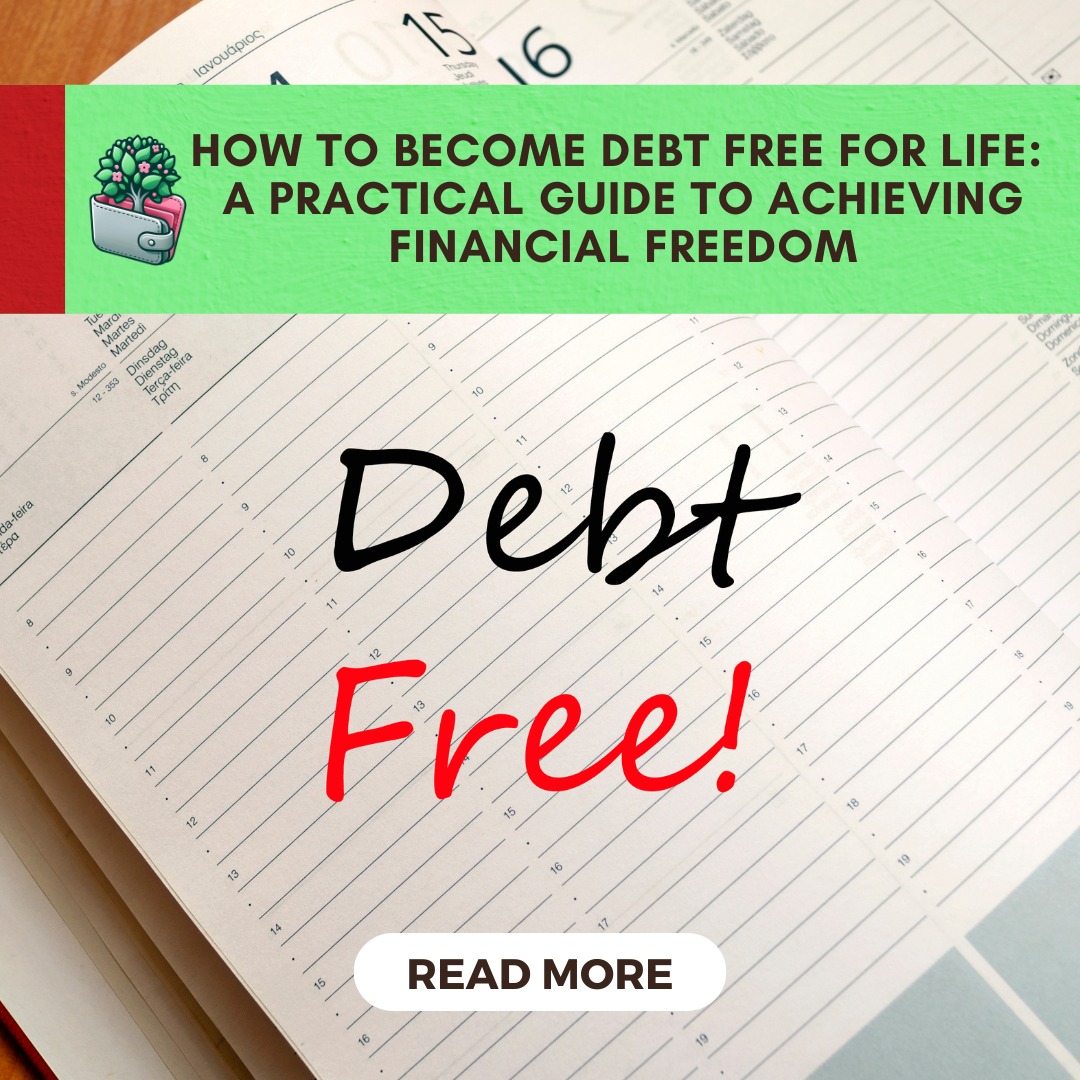Are you tired of feeling trapped by debt? Do you dream of a life where you’re not constantly worrying about bills and financial obligations? You’re not alone. Millions of people around the world struggle with debt, but the good news is that it’s possible to break free and achieve financial freedom.
In this comprehensive guide, I’ll share practical strategies and actionable advice to help you become debt free for life. As a seasoned finance expert, I’ve helped countless individuals overcome their financial challenges and achieve their dreams. Together, we’ll explore effective debt reduction techniques, create a personalized debt repayment plan, and build a solid foundation for a financially secure future.
Get ready to take control of your finances and embark on a journey toward a debt-free life. Let’s dive in and discover how you can achieve financial freedom once and for all.

Understanding the Benefits of Becoming Debt Free for Life
Living debt-free means having no outstanding debts, such as credit card debt, personal loans, or mortgages. This financial freedom can significantly reduce stress and improve your mental health. By eliminating debt, you gain more control over your finances, allowing you to make informed decisions about your money.
Additionally, living debt-free can boost your credit score and increase your overall financial stability.
According to CNBC, “For many, living debt-free is a dream that unfortunately may feel far from reality. Whether it’s a matter of strategic debt, such as a low-interest-rate mortgage or student loans, or high-interest-consumer debt that’s from a credit card, many Americans are accustomed to living in the red.”

Assessing Your Debt Situation
To effectively manage your debt, begin by gathering all your financial documents, such as credit card statements and loan papers. Create a comprehensive list of all your debts, including the balance, interest rate, and minimum payment for each.
Calculate the total amount of debt you owe and the total interest payments you make each month. This will provide you with a clear picture of your financial situation. Prioritize paying off high-interest debts, such as credit card balances, to minimize the amount of interest you pay over time.
Creating a Plan to Pay Off Debt
1. Choose a Debt Repayment Strategy
- Debt Snowball Method: This method involves paying off debts with the smallest balances first, regardless of interest rates. While it may not save you the most money in interest, it can provide a sense of accomplishment and motivation as you quickly pay off debts.
- Debt Avalanche Method: This method focuses on paying off debts with the highest interest rates first, which can save you money in the long run. However, it may take longer to see progress, as you’ll be tackling larger balances.
2. Create a Detailed Budget
- Track your income and expenses: Carefully monitor your income and expenses to identify areas where you can cut back.
- Allocate funds for debt repayment: Allocate as much of your income as possible towards debt repayment.
- Prioritize debt payments: Ensure that your debt payments are made on time and in full.

3. Consider Debt Consolidation
- Evaluate your options: Explore debt consolidation options, such as personal loans or balance transfers, which may offer lower interest rates.
- Compare terms and conditions: Carefully compare the terms and conditions of different consolidation options to find the best fit for your situation.
4. Stay Motivated and Persistent
- Celebrate milestones: Celebrate your progress along the way to stay motivated.
- Seek support: Don’t hesitate to seek support from friends, family, or financial advisors.
- Stay focused on your goal: Remember your ultimate goal of becoming debt-free and stay committed to your plan.
Avoiding Debt Traps and Staying on Track
Be mindful of lifestyle inflation to avoid falling back into bad debt. As your income increases, resist the urge to increase your spending accordingly. Be cautious of credit card offers and avoid taking on new debt.
Consider implementing a “no-spend” day or week to help you stay disciplined and focused on your debt repayment goals. Regularly review your budget and debt repayment plan to ensure you’re on track and make necessary adjustments as needed.
Doing this will help you adopt a debt-free lifestyle, save more money in the long run, and eventually up your financial circumstances.
According to Tonik Bank, “A debt-free life sounds like paradise. You get more freedom, more peace of mind, and more opportunities to enjoy the things you love. However, we want to make one thing clear: debts aren’t all that bad, especially if they help you build credit!”

Building an Emergency Fund
An emergency fund is a vital component of a solid financial plan. Aim to save between three to six months’ worth of your living expenses in an easily accessible savings account. This fund will provide a safety net to cover unexpected expenses, such as car repairs, medical bills, or job loss.
Avoid using your emergency fund for non-essential expenses to ensure it remains available for true emergencies. To make saving easier, consider setting up automatic transfers from your checking account to your emergency fund.
Strategies for Achieving Financial Freedom
1. Increase Your Income
– Explore side hustles: Find ways to earn extra income, such as freelancing, tutoring, or selling items online.
– Negotiate a raise: If you’re satisfied with your current job, consider negotiating a higher salary.
– Develop new skills: Invest in your education and training to increase your earning potential.
2. Reduce Your Expenses
– Create a detailed budget: Track your income and expenses to identify areas where you can cut back.
– Eliminate unnecessary expenses: Consider canceling subscriptions, reducing dining out, or finding cheaper alternatives for entertainment.
– Negotiate bills: Try negotiating lower rates for your utilities, insurance, or other bills.

3. Allocate Your Income Wisely
– Follow the 50/30/20 rule: Allocate 50% of your income towards necessities, 30% towards discretionary spending, and 20% towards saving and debt repayment.
– Prioritize essential expenses: Ensure that you have enough money to cover your basic needs, such as housing, food, and transportation.
4. Seek Professional Help
– Consult a financial advisor: A financial advisor can provide personalized guidance and advice.
– Consider debt management programs: Debt management plans can help you create a structured repayment plan and negotiate with creditors.
– Seek credit counseling: Credit counseling services can offer education and support to help you manage your finances.
5. Avoid Taking on New Debt
– Resist the urge to borrow: Avoid taking on new debt, such as credit accounts debt or personal loans, while you’re working to pay off existing debts.
– Focus on building savings: Instead of borrowing, prioritize building an emergency fund to cover unexpected expenses.
Building a Budget for Long-Term Success
To achieve long-term financial success, it’s essential to create a comprehensive budget that accounts for all of your income and expenses.
Prioritize needs over wants, allocating as much money as possible towards saving and debt repayment. Consider using a budgeting app or spreadsheet to effectively track your expenses and stay on top of your finances.
Regularly review and adjust your budget to ensure it aligns with your changing circumstances and helps you stay on track toward achieving your financial goals.

Maintaining Financial Discipline
Setting clear financial goals and tracking your progress is essential for maintaining financial discipline. Avoid impulse purchases and prioritize needs over wants. Consider implementing a “30-day rule” to prevent unnecessary spending. Regularly review your budget and debt repayment plan to stay on course toward achieving your financial goals.
By staying disciplined and focused, you can build a strong financial foundation and secure a brighter future.
According to Bankrate, “Perhaps it was impulse buying that got you into debt in the first place. If so, you may need to change your mindset to live debt-free. Emotional spending, often triggered by feelings like sadness, boredom, fear or insecurity, can quickly lead to spending beyond your budget.”
Achieving Long-Term Financial Success
To secure a comfortable retirement, consider investing in a retirement account, such as a 401(k) or IRA. Aim to save at least 10% to 15% of your income towards retirement. Working with a financial advisor can help you create a personalized investment plan that aligns with your financial goals and risk tolerance.
By taking proactive steps toward retirement planning, you can create a financially secure future.
Conclusion: A Debt-Free Future Awaits
By following the practical personal finance strategies outlined in this guide, you can break free from the chains of debt and achieve financial freedom. Remember, it’s a journey that requires patience, perseverance, and a commitment to your goals. But the rewards are immeasurable – a stress-free life, financial security, and the freedom to pursue your dreams.
So, take the first step towards a debt-free future today. With determination and the right strategies, you can overcome your financial challenges and create a brighter tomorrow.


